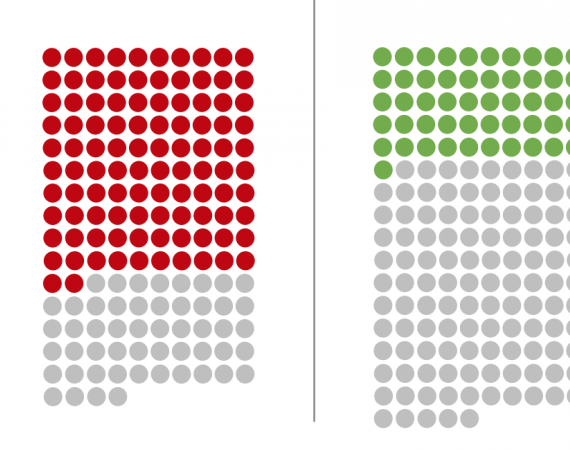Posted on Thu 29 Jul 2021
Studio Resident Community Inclusion Report 2016-2020
A 4 year overview of the make-up of the PM Studio Community, and an introduction to the approach we took when compiling the report

An example graph of green and purple dots
Sharing this report has taken longer than we would have liked, but it is one of the first steps in reimagining our approach to inclusion data, which has included identifying where our gaps our (in both the data, and our approach), and looking to how we can address these going forward. Before reading the report it is important to acknowledge that at the time this data was collected, there were flaws in our approach in terms of both language and the structuring of the data collection itself.
With that in mind our aim with this report has been to:
- share the existing studio community inclusion data in a clear and transparent way
- outline those areas we have identified so far that need addressing
- and most importantly, to invite the studio community to feedback and work with us to ensure we approach this area of work in most inclusive way possible.
Details of how you can get in touch are listed on page 26 and at the end of this report. The report itself contains both some context in terms of how we’ve approached the data, what our points of reference have been so far, the data itself, and also an outline of what our next steps are.
Watershed’s approach to data led inclusion means looking at who we are, who has a seat at the table and who we are supporting so that we can intentionally and directly make paths to readdress inequities. For Pervasive Media Studio this focuses on studio-wide surveying that looks deeply and honestly at the community’s demographics with a determination to keep data collection consensual and transparent.
In Autumn 2020, Watershed set-up an inclusion data working group to specifically work on this, dedicating time to thoughtful work focusing on;
- how we ask questions; including researching best practice from across the arts, culture, academic and government sectors
- what language we use; acknowledging the impact that language can have in promoting an inclusive workplace and culture, again by researching and referencing best practice with the aim to make the language we use as accessible as possible (a breakdown of our references can be found at the end of this report)
- how we analyse and present the data; acknowledging the potential for bias in the presentation and interpretation of data, with an aim to make the data as transparent and equitable as possible
Whilst our aim is always to approach this in the most inclusive way we can, we also acknowledge that language and meaning is constantly changing. We are committed to, and will rely on, being open to feedback and discussion to constantly develop our approach to ensure we are as up to date as possible.
Read or download the report the report to find out more